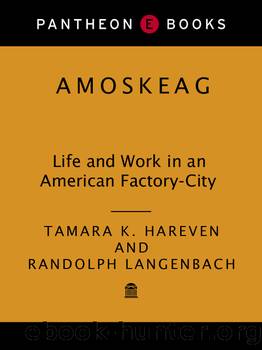Amoskeag by Tamara K. Hareven

Author:Tamara K. Hareven [Hareven, Tamara K.]
Language: eng
Format: epub
ISBN: 978-0-307-83159-0
Publisher: Knopf Doubleday Publishing Group
Published: 2013-04-10T00:00:00+00:00
Cora Pellerin, 1977
We had a good time in the spinning room. After we got our pay, every time we had something new, weâd stay out to show off our new clothes. In those days it wasnât like today. Weâd get dressed for the holidays. It was a mustâyou had to have something new. At Easter weâd have something like a new coat, new shoes, new hat; and weâd stay out the week after we got our pay. They used to come on Thursday at two oâclock to give us our pay. Weâd take turns. We didnât all stay out the same day. I would stay out one Thursday, then the following week my girlfriend, and then the following week it was another oneâs turn [laughs]. I never would wear the clothes from the mill in the house. We changed in the mill. I made my own smock to wear there. It had to have pockets to put the scissors and roving in.
When I was seventeen, I got my own room. I lived there for four years, and then I got an apartment all by myself. I had nice furniture because a furniture store furnished the apartment. I used to pay $5.00 per week for everything. In the corporations it was much cheaper, but you couldnât get an apartment in the corporations if you werenât married. It was family housing.
Not too many women were living alone in their own apartments. I was a wildcat [laughs]. Some mothers of my girlfriends, after they knew that I was in an apartment, they didnât want their daughters to chum around with me any more. In those days, if you lived alone in a room, they were afraid their daughters would get the idea.
I had my own home, I had everything. I cooked my own food. I didnât have to go to the boardinghouse and eat what they had. I learned how to make pie and bake my own beans, and I liked that. My boyfriend, who became my husband, came to see me. He was welcome any time he wanted to come. He was fifteen years older than I.
In 1918, I started to weave. I had a very good teacher. She was the niece of the woman who ran the boardinghouse where I lived. The woman said, âIf sheâs going to make a weaver out of you, it wonât take long.â I was a little bit afraid of her. They give you two weeks to learn. So the first day of the second week I started two looms, then three, and by noontime I had four looms going, and I kept them going all day. She said, âHey, start another one and Iâll keep a watch on it.â We had six looms for a full set. So I started another one. By that second week I had all my six looms going.
My work was handloomsâfour-shuttle, four-color.* Some weavers weave all their lives and never get the hang of it. Some women especially, they just weave because they have to earn money; they never apply themselves to it.
Download
This site does not store any files on its server. We only index and link to content provided by other sites. Please contact the content providers to delete copyright contents if any and email us, we'll remove relevant links or contents immediately.
Whiskies Galore by Ian Buxton(40332)
Introduction to Aircraft Design (Cambridge Aerospace Series) by John P. Fielding(32338)
Small Unmanned Fixed-wing Aircraft Design by Andrew J. Keane Andras Sobester James P. Scanlan & András Sóbester & James P. Scanlan(32141)
Craft Beer for the Homebrewer by Michael Agnew(17447)
Turbulence by E. J. Noyes(7039)
The Complete Stick Figure Physics Tutorials by Allen Sarah(6638)
Kaplan MCAT General Chemistry Review by Kaplan(6054)
The Thirst by Nesbo Jo(5786)
Bad Blood by John Carreyrou(5769)
Learning SQL by Alan Beaulieu(5412)
Weapons of Math Destruction by Cathy O'Neil(5037)
Man-made Catastrophes and Risk Information Concealment by Dmitry Chernov & Didier Sornette(4737)
iGen by Jean M. Twenge(4702)
Digital Minimalism by Cal Newport;(4544)
Life 3.0: Being Human in the Age of Artificial Intelligence by Tegmark Max(4508)
Audition by Ryu Murakami(4099)
1,001 ASVAB Practice Questions For Dummies by Powers Rod(4039)
Electronic Devices & Circuits by Jacob Millman & Christos C. Halkias(4029)
Pale Blue Dot by Carl Sagan(4001)
